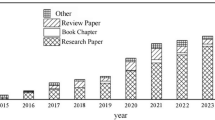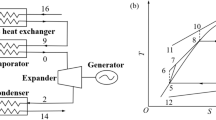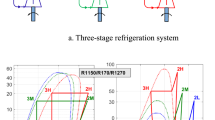Abstract
This article presents a novel energy management strategy of multiple-stage evaporator (MSE). The maximum efficiency of MSE is achieved by optimum selection of unknown steady-state process parameters such as vapor temperatures and liquor flow rates. Various energy reduction schemes (ERSs) have been integrated to achieve a substantial enhancement in energy efficiency. For energy optimization, a set of nonlinear mathematical models for various ERSs are formulated and transformed to optimization problems. Three nature-inspired algorithms, namely GA, DE and PSO, are employed to compute these optimal process parameters and hence evaluate the energy efficiency. The simulated results accentuate that these algorithms efficiently converge approximately at the same values. The results reveal that the hybrid model with maximum efficiency of 8.24 is characterized as the most energy-efficient operating strategy. The amalgamation of flash tanks with the intention of reutilizing the waste steam further enhances the energy efficiency by 4.97%, thereby proving to be the most prominent operating strategy with the highest efficiency of 8.65.










Similar content being viewed by others
Explore related subjects
Discover the latest articles and news from researchers in related subjects, suggested using machine learning.Abbreviations
- λ :
-
Latent heat of vaporization (kJ/kg)
- A :
-
Heat transfer area (m2)
- Cp :
-
Specific heat
- f :
-
Feed
- h :
-
Enthalpy (kJ/h)
- h c :
-
Enthalpy of condensate (kJ/h)
- h LP :
-
Liquor enthalpy for product flash tank
- H :
-
Enthalpy of vapor (kJ/h)
- H vp :
-
Enthalpy of vapor out from product flash tank (kJ/h)
- i :
-
Stage number
- J :
-
Objective function
- k :
-
Feed split fraction
- L :
-
Liquor flow rate (kg/s)
- L f :
-
Weak liquor feed flow rate
- L p :
-
Concentrated product liquor flow rate
- m :
-
Vapor fraction of preheater send to the seventh stage
- U :
-
Overall heat transfer coefficient (kW/m2°C)
- V :
-
Vapor flow (kg/s)
- V p :
-
Vapor out from product flash tank
- X :
-
Concentration of liquor
- y :
-
Steam split fraction
- z :
-
Decision variables
- CFV:
-
Condensate flash vessel
- CO:
-
Condensate out
- DE:
-
Differential evolution
- ERS:
-
Energy reduction scheme
- FFT:
-
Feed flash tank
- GA:
-
Genetic algorithm
- NIA:
-
Nature-inspired algorithm
- PFT:
-
Product flash tank
- PH:
-
Preheater
- PSO:
-
Particle swarm optimization
- SNLAE:
-
Set of nonlinear algebraic equations
References
Golley J, Tyers R (2013) Contrasting giants: demographic change and economic performance in China and India. Procedia Soc Behav Sci 77:353–383. https://doi.org/10.1016/j.sbspro.2013.03.093
Wei Y, Wang Z, Wang H et al (2019) Predicting population age structures of China, India, and Vietnam by 2030 based on compositional data. PLoS ONE. https://doi.org/10.1371/journal.pone.0212772
Froese FJ, Sutherland D, Lee JY et al (2019) Challenges for foreign companies in China: implications for research and practice. Asian Bus Manag 18:249–262. https://doi.org/10.1057/s41291-019-00084-0
Chen X, Kuhn E, Nagle N et al (2018) Recycling of dilute deacetylation black liquor to enable efficient recovery and reuse of spent chemicals and biomass pretreatment waste. Front Energy Res. https://doi.org/10.3389/fenrg.2018.00051
AL-Kaabi Z, Pradhan R, Thevathasan N et al (2018) Beneficiation of renewable industrial wastes from paper and pulp processing. AIMS Energy 6:880–907
Naqvi M, Yan J, Dahlquist E (2010) Black liquor gasification integrated in pulp and paper mills: a critical review. Bioresour Technol 101:8001–8015. https://doi.org/10.1016/j.biortech.2010.05.013
Naqvi M, Yan J, Dahlquist E (2012) Energy conversion performance of black liquor gasification to hydrogen production using direct causticization with CO2 capture. Bioresour Technol 110:637–644. https://doi.org/10.1016/j.biortech.2012.01.070
Gupta GK, Shukla P (2019) Insights into the resources generation from pulp and paper industry wastes: challenges, perspectives and innovations. Bioresour Technol. https://doi.org/10.1016/j.biortech.2019.122496
Khanam S, Mohanty B (2010) Energy reduction schemes for multiple effect evaporator systems. Appl Energy 87:1102–1111. https://doi.org/10.1016/j.apenergy.2009.05.003
Verma OP, Manik G, Sethi SK (2019) A comprehensive review of renewable energy source on energy optimization of black liquor in MSE using steady and dynamic state modeling, simulation and control. Renew Sustain Energy Rev 100:90–109. https://doi.org/10.1016/j.rser.2018.10.002
Kaya D, Ibrahim Sarac H (2007) Mathematical modeling of multiple-effect evaporators and energy economy. Energy 32:1536–1542. https://doi.org/10.1016/j.energy.2006.09.002
Sharan P, Bandyopadhyay S (2016) Integration of thermo-vapor compressor with multiple-effect evaporator. Appl Energy 184:560–573. https://doi.org/10.1016/j.apenergy.2016.10.037
Sharan P, Neises T, Turchi C (2018) Optimal feed flow sequence for multi-effect distillation system integrated with supercritical carbon dioxide Brayton cycle for seawater desalination. J Clean Prod 196:889–901. https://doi.org/10.1016/J.JCLEPRO.2018.06.009
Bhargava R, Khanam S, Mohanty B, Ray AK (2008) Selection of optimal feed flow sequence for a multiple effect evaporator system. Comput Chem Eng 32:2203–2216. https://doi.org/10.1016/j.compchemeng.2007.10.012
Hillenbrand JB, Westerberg AW (1988) The synthesis of multiple-effect evaporator systems using minimum utility insights-I. A cascaded heat representation. Comput Chem Eng 12:611–624. https://doi.org/10.1016/0098-1354(88)80003-6
Verma OP, Manik G, Mohammed TH (2017) Energy management in multi stage evaporator through a steady and dynamic state analysis. Korean J Chem Eng 34:2570–2583. https://doi.org/10.1007/s11814-017-0180-4
Karlsson M (2011) The MIND method: a decision support for optimization of industrial energy systems—principles and case studies. Appl Energy 88:577–589. https://doi.org/10.1016/j.apenergy.2010.08.021
Verma OP, Mohammed TH, Mangal S, Manik G (2016) Mathematical modeling of multistage evaporator system in Kraft recovery process. In: Pant M, Deep K, Bansal JC et al (eds) Proceedings of fifth international conference on soft computing for problem solving: SocProS 2015, vol 2. Springer Singapore, Singapore, pp 1011–1042
Verma OP, Mohammed TH, Mangal S, Manik G (2017) Minimization of energy consumption in multi-stage evaporator system of Kraft recovery process using interior-point method. Energy 129:148–157. https://doi.org/10.1016/j.energy.2017.04.093
Lambert RN, Joye DD, Koko FW (1987) Design calculations for multiple-effect evaporators. 1. Linear method. Ind Eng Chem Res 26:100–104. https://doi.org/10.1021/ie00061a019
Danish M, Singh SP (2014) A short note on the solution of a multi-effect evaporator system employed in pulp and paper industry. Appl Math Model 38:4157–4160. https://doi.org/10.1016/j.apm.2014.01.003
Kumar D, Kumar V, Singh VP (2010) To study the parametric effects on optimality of various feeding sequences of a multi- effect evaporators in paper industry using mathematical modeling and simulation with MATLAB. Engineering 4:129–136
Zain OS, Kumar S (1996) Simulation of a multiple effect evaporator for concentrating caustic soda solution-computational aspects. J Chem Eng Japan 29:889–893
Ribeiro CP, Caño Andrade MH (2002) A heat transfer model for the steady-state simulation of climbing-falling-film plate evaporators. J Food Eng 54:309–320. https://doi.org/10.1016/S0260-8774(01)00217-5
Sagharichiha M, Jafarian A, Asgari M, Kouhikamali R (2014) Simulation of a forward feed multiple effect desalination plant with vertical tube evaporators. Chem Eng Process Process Intensif 75:110–118. https://doi.org/10.1016/j.cep.2013.11.008
Diel CL, Canevesi RLS, Zempulski DA et al (2016) Optimization of multiple-effect evaporation in the pulp and paper industry using response surface methodology. Appl Therm Eng 95:18–23. https://doi.org/10.1016/j.applthermaleng.2015.10.136
Tijskens E, Roose D, Ramon H, De Baerdemaeker J (2002) Automatic differentiation for solving nonlinear partial differential equations: an efficient operator overloading approach. Numer Algorithms 30:259–301. https://doi.org/10.1023/A:1020103610525
Jameel AF, Saaban A, Zureigat HH (2018) Numerical solution of second-order fuzzy nonlinear two-point boundary value problems using combination of finite difference and Newton’s methods. Neural Comput Appl 30:3167–3175. https://doi.org/10.1007/s00521-017-2893-z
Venkateshan SP, Swaminathan P (2014) Solution of algebraic equations. In: Computational methods in engineering. Elsevier, pp 155–201
Verma OP, Suryakant Manik G (2017) Solution of SNLAE model of backward feed multiple effect evaporator system using genetic algorithm approach. Int J Syst Assur Eng Manag 8:63–78. https://doi.org/10.1007/s13198-016-0533-0
Morandin M, Toffolo A, Lazzaretto A et al (2011) Synthesis and parameter optimization of a combined sugar and ethanol production process integrated with a CHP system. Energy 36:3675–3690. https://doi.org/10.1016/j.energy.2010.10.063
Sharan P, Bandyopadhyay S (2016) Energy integration of multiple effect evaporators with background process and appropriate temperature selection. Ind Eng Chem Res 55:1630–1641. https://doi.org/10.1021/acs.iecr.5b03516
Cortés MG, Verelst H, Suárez EG (2010) Energy integration of multiple effect evaporators in sugar process production. Chem Eng Trans 21:277–282. https://doi.org/10.3303/CET1021047
Pourrajabian A, Ebrahimi R, Mirzaei M, Shams M (2013) Applying genetic algorithms for solving nonlinear algebraic equations. Appl Math Comput 219:11483–11494. https://doi.org/10.1016/j.amc.2013.05.057
Jaberipour M, Khorram E, Karimi B (2011) Particle swarm algorithm for solving systems of nonlinear equations. Comput Math Appl 62:566–576. https://doi.org/10.1016/j.camwa.2011.05.031
Chi R, Su YX, Zhang DH et al (2019) A hybridization of cuckoo search and particle swarm optimization for solving optimization problems. Neural Comput Appl 31:653–670. https://doi.org/10.1007/s00521-017-3012-x
Qiao JF, Hou Y, Han HG (2019) Optimal control for wastewater treatment process based on an adaptive multi-objective differential evolution algorithm. Neural Comput Appl 31:2537–2550. https://doi.org/10.1007/s00521-017-3212-4
Pandey HM (2017) performance review of harmony search, differential evolution and particle swarm optimization. In: IOP conference series: materials science and engineering. Institute of Physics Publishing
Pandey HM, Shukla A, Chaudhary A, Mehrotra D (2016) Evaluation of genetic algorithm’s selection methods. In: Advances in intelligent systems and computing. Springer Verlag, pp 731–738
Agrawal AP, Choudhary A, Kaur A, Pandey HM (2019) Fault coverage-based test suite optimization method for regression testing: learning from mistakes-based approach. Neural Comput Appl. https://doi.org/10.1007/s00521-019-04098-9
Loghmanian SMR, Jamaluddin H, Ahmad R et al (2012) Structure optimization of neural network for dynamic system modeling using multi-objective genetic algorithm. Neural Comput Appl 21:1281–1295. https://doi.org/10.1007/s00521-011-0560-3
Sacco WF, Henderson N (2011) Finding all solutions of nonlinear systems using a hybrid metaheuristic with fuzzy clustering means. Appl Soft Comput J 11:5424–5432. https://doi.org/10.1016/j.asoc.2011.05.016
Waseem M, Noor MA, Noor KI (2016) Efficient method for solving a system of nonlinear equations. Appl Math Comput 275:134–146. https://doi.org/10.1016/j.amc.2015.11.061
Koupaei JA, Hosseini SMM (2015) A new hybrid algorithm based on chaotic maps for solving systems of nonlinear equations. Chaos Solitons Fractals 81:233–245. https://doi.org/10.1016/j.chaos.2015.09.027
Pandey HM (2016) performance evaluation of selection methods of genetic algorithm and network security concerns. In: Physics procedia. Elsevier B.V., pp 13–18
Mateos-Espejel E, Savulescu L, Paris J (2011) Base case process development for energy efficiency improvement, application to a Kraft pulping mill. Part I: definition and characterization. Chem Eng Res Des 89:742–752. https://doi.org/10.1016/j.cherd.2010.09.012
Verma OP, Mohammed TH, Mangal S, Manik G (2018) Optimization of steam economy and consumption of heptad’s effect evaporator system in Kraft recovery process. Int J Syst Assur Eng Manag 9:111–130. https://doi.org/10.1007/s13198-016-0488-1
Pandey HM, Chaudhary A, Mehrotra D (2014) A comparative review of approaches to prevent premature convergence in GA. Appl Soft Comput J 24:1047–1077
Shukla A, Pandey HM, Mehrotra D (2015) Comparative review of selection techniques in genetic algorithm. In: 2015 1st international conference on futuristic trends in computational analysis and knowledge management, ABLAZE 2015. Institute of Electrical and Electronics Engineers Inc., pp 515–519
Pandey HM, Chaudhary A, Mehrotra D (2016) Grammar induction using bit masking oriented genetic algorithm and comparative analysis. Appl Soft Comput J 38:453–468. https://doi.org/10.1016/j.asoc.2015.09.044
Author information
Authors and Affiliations
Corresponding author
Ethics declarations
Conflict of interest
All authors declare that they have no conflict of interest.
Additional information
Publisher's Note
Springer Nature remains neutral with regard to jurisdictional claims in published maps and institutional affiliations.
Rights and permissions
About this article
Cite this article
Pati, S., Yadav, D. & Verma, O.P. Synergetic fusion of energy optimization and waste heat reutilization using nature-inspired algorithms: a case study of Kraft recovery process. Neural Comput & Applic 33, 10751–10770 (2021). https://doi.org/10.1007/s00521-020-04828-4
Received:
Accepted:
Published:
Issue Date:
DOI: https://doi.org/10.1007/s00521-020-04828-4




